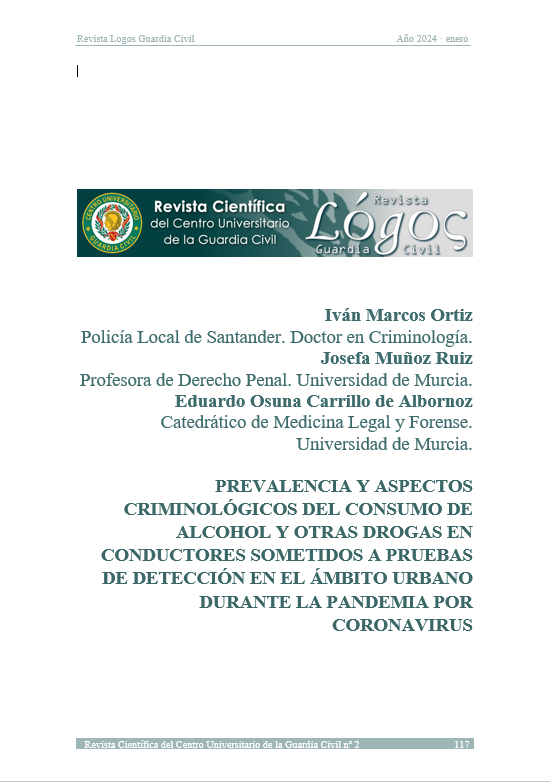Prevalence and criminological aspects of alcohol and other drugs use among drivers subjected to detection tests in the urban environment during the coronavirus pandemic
Keywords:
Alcohol, Drugs, Road safety, COVID-19Abstract
Traffic accidents constitute a public health problem. The relationship between traffic accidents and the consumption of toxic substances is undeniable. In 2020, the COVID-19 pandemic caused an unprecedented health crisis which led to measures being adopted in limiting citizen mobility. A subsequent change in the consumption patterns of toxic substances was also observed. There was a decrease in the prevalence of alcohol, tobacco, cannabis, and cocaine use, and contrarily an increase in the consumption of non-prescription sedatives. The aim of this study is to analyze the prevalence of alcohol use and other psychoactive substances in a population of drivers subjected to alcohol and other drug testing in urban areas. This study evaluates the possible impact that mobility restriction measures adopted during the pandemic had on road safety. To achieve this, we carried out a cross-sectional descriptive study on vehicle drivers on urban roads and crossings in the city of Santander in the year 2020, where we conducted 3,680 alcohol tests and 275 other drug tests. Our results demonstrate that positive results for alcohol and/or other drugs were found in 20.82% of the cases. The profile of the driver positive for alcohol shows a male driver between the ages of 25 and 44, who drives during the weekend between 11 pm and 7 am and presents a breath alcohol level higher than 0.60 mg/l. The profile of the driver positive for other drugs is male, between 25 and 44 years old, who drives with a uniform distribution throughout the week, in the period between 7 pm and midnight. The main substances in this profile are cannabis (75.31%) and cocaine (44.03%). It is confirmed that during the months without confinement, 13.02% of the alcohol tests and 30.19% of other drug tests were positive, while during the confinement period the percentages rose to 23.44% and 38.57%, respectively.
Downloads
References
BIBLIOGRAFÍA
Comisión Europea. (2023). Seguridad vial en la UE: el número de víctimas mortales se mantiene por debajo de los niveles previos a la pandemia, pero los avances son demasiado lentos [Comunicado de prensa]. https://ec.europa.eu/commission/presscorner/api/files/document/print/es/ip_23_953/IP_23_953_ES.pdf
Delegación del Gobierno para el Plan Nacional sobre Drogas. (2022). EDADES 2022. Encuesta sobre el alcohol y otras drogas en España (EDADES), 1995-2022 (pp. 15-32). https://pnsd.sanidad.gob.es/profesionales/sistemasInformacion/sistemaInformacion/pdf/2022_Informe_EDADES.pdf
Felson, M., & Clarke, R.V. (1998). Opportunity Makes the Thief. Practical theory for crime prevention (pp. 4-32). London: Home Office, Policing and Reducing Crime Unit, Research, Development and Statistics Directorate.
Fiscalía General del Estado. (2023). Memoria de la Fiscalía General del Estado de 2023 (p. 165). https://www.fiscal.es/memorias/memoria2023/FISCALIA_SITE/recursos/pdf/capitulo_III/cap_III_5_4.pdf
Fundación General Universidad de Valladolid, & Observatorio Nacional de Seguridad Vial. (2022). Estudio de prevalencia del consumo de sustancias psicoactivas en conductores de vehículos en España: EDAP 2021 (p. 32). DGT. https://www.dgt.es/export/sites/web-DGT/.galleries/downloads/conoce_la_dgt/que-hacemos/conocimiento-e-investigacion/EDAP-2021_Accesible-con-Meta.pdf
Instituto Nacional de Toxicología y Ciencias Forenses (INTCF). (2023). Hallazgos toxicológicos en víctimas mortales de accidentes de tráfico. Memoria 2022 (p. 13). https://www.mjusticia.gob.es/es/ElMinisterio/OrganismosMinisterio/Documents/HallazgosToxicologicosVictimasMortales2022%20%281%29.pdf
Observatorio Español de las Drogas y las Adicciones (OEDA). (2020). Encuesta OEDA-COVID 2020 (p. 24). https://pnsd.sanidad.gob.es/profesionales/sistemasInformacion/sistemaInformacion/COVID-19/20210326_Informe_ENCUESTA_OEDA-COVID_2020_def.pdf
Organización Mundial de la Salud. (2018). Global status report on road safety 2018 (p. IX). https://iris.who.int/bitstream/handle/10665/276462/9789241565684-eng.pdf?sequence=1
Redondo Illescas, S., & Garrido Genovés, V. (2013). Principios de criminología. 4a edición (pp. 487-492). Valencia: Tirant Lo Blanch.
LEGISLACIÓN
Fiscalía General del Estado. (2019, 18 de julio). Oficio del Fiscal de Sala Coordinador a las policías judiciales de tráfico con instrucciones para la elaboración de atestados por delitos de conducción bajo la influencia de drogas tóxicas, estupefacientes y sustancias psicotrópicas del art. 379.2 del Código Penal.
Ley de Cantabria 1/2002, de 26 de febrero, del Comercio de Cantabria. Boletín Oficial del Estado, 79, de 2 de abril de 2002. https://www.boe.es/buscar/pdf/2002/BOE-A-2002-6232-consolidado.pdf
Ley de Cantabria 5/1997, de 6 de octubre, de Prevención, Asistencia e Incorporación Social en Materia de Drogodependencias. Boletín Oficial del Estado, 283, de 26 de noviembre de 1997. https://www.boe.es/buscar/pdf/1997/BOE-A-1997-25123-consolidado.pdf
Ley Orgánica 4/2015, de 30 de marzo, de protección de la seguridad ciudadana. Boletín Oficial del Estado, 77, de 31 de marzo de 2015. https://www.boe.es/buscar/pdf/2015/BOE-A-2015-3442-consolidado.pdf
Real Decreto 1428/2003, de 21 de noviembre, por el que se aprueba el Reglamento General de Circulación para la aplicación y desarrollo del texto articulado de la Ley sobre tráfico, circulación de vehículos a motor y seguridad vial, aprobado por el Real Decreto Legislativo 339/1990, de 2 de marzo. Boletín Oficial del Estado, 306, de 23 de diciembre de 2003. https://www.boe.es/buscar/pdf/2003/BOE-A-2003-23514-consolidado.pdf

Downloads
Published
How to Cite
Issue
Section
License
Copyright (c) 2024 Iván Marcos Ortiz, Josefa Muñoz Ruiz, Eduardo Osuna Carrillo de Albornoz

This work is licensed under a Creative Commons Attribution-NonCommercial-NoDerivatives 4.0 International License.
-
Attribution — You must give appropriate credit, provide a link to the license, and indicate if changes were made. You may do so in any reasonable manner, but not in any way that suggests the licensor endorses you or your use.
-
NonCommercial — You may not use the material for commercial purposes.
-
NoDerivatives — If you remix, transform, or build upon the material, you may not distribute the modified material.
- No additional restrictions — You may not apply legal terms or technological measures that legally restrict others from doing anything the license permits.



